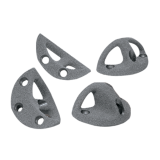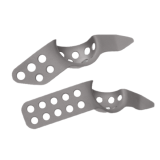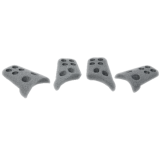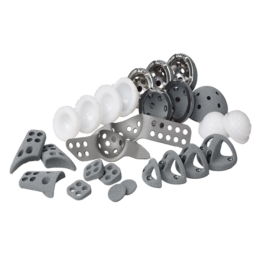Trabecular Metal Revision Shell
The Trabecular Metal Revision Shell provides both initial and long-term stability due to its high coefficient of friction against bone with up to 80% porosity to enable ingrowth.1-4
Low modulus of elasticity of Trabecular Metal material can produce more normal physiological loading and reduce stress shielding.5
One-piece construct, created by cementing the liner, eliminates concerns about backside wear.
Elliptical geometry creates a 2-mm interference fit at the periphery of the shell, maximizing bone contact for initial stability.6
The shell is designed for use in revision and primary cases, and it is placed in best position for maximum host bone contact, while 0 degree neutral and 10 degree oblique liners allow for preferred version.
Dome screw holes allow for additional fixation into structural bone.
Longevity® Highly Crosslinked Polyethylene liners in various configurations are available to best meet patient needs.
Trabecular Metal Material has physical and mechanical properties similar to cancellous bone due to its high compressive strength and low modulus of elasticity.1,3
Trabecular Metal Buttress
The Zimmer® Trabecular Metal Acetabular Revision System sets new standards in the way surgeons perform revision surgery. It combines Trabecular Metal Technology with the ability to tailor individualized solutions for each patient—a combination no other competitive system offers.
The Trabecular Metal Buttress:
- Is made entirely of Trabecular Metal Material—no substrate
- It addresses extensive superior segmental defects (Paprosky Type IIIA)
- Serves as an alternative to allograft, without potential for bone resorption or disease transmission
- Is designed to provide a technically simpler procedure, compared to using structural allograft
- Interfaces are cemented, creating a monolithic construct without concerns for micromotion
- Host bone is conserved while implant size, position, and orientation are determined by the defect
- Allows head center to be restored for optimization of patient kinetics
Trabecular Metal Cup Cage
No other prosthetic material simulates bone like Trabecular Metal Material. It’s a 3-dimensional, porous material, not merely a coating. Additionally, it’s one of the most biocompatible materials in the orthopedics industry.
The Trabecular Metal Cup Cage features include:
- Cage manufactured of commercially pure titanium for optimized mechanical strength
- Left and right configurations
- Long-flange and short-flange
- Inferior flange designed to be spiked into ischium
- Shaped to fit individual patient anatomy
- Used where Trabecular Metal Revision Shell alone does not provide adequate stability
- Cage spans acetabular defects and pelvic discontinuities to provide mechanical stability of the Cup-Cage construct until biological ingrowth occurs within the Trabecular Metal Revision Shell
without concerns of micromotion - Cementing the Longevity Highly Crosslinked Polyethylene Liners, Cages, and Trabecular Metal Revision Shells together creates a single construct, without concerns of micromotion
Product Brochure
References
- Bobyn JD, Hacking SA, Chan SP, et al. Characterization of a new porous tantalum biomaterial for reconstructive orthopaedics. Scientific Exhibit, Proc of AAOS, Anaheim, CA. 1999.
- JD Bobyn, GJ Stackpool, SA Hacking, M Tanzer, JJ Krygier, Characteristics of Bone In-Growth and Interface Mechanics of a New Porous Tantalum Biomaterial, The Journal of Bone and Joint Surgery (British Version), Sept, 1999, 81-B No. 5 pp 907-914.
- Zhang Y, Ahn PB, Fitzpatrick DC, Heiner AD, Poggie RA, Brown TD, “Interfacial frictional behavior: Cancellous bone, cortical bone, and a novel porous tantalum biomaterial”, Journal of Musculoskeletal Research, 3(4): 245-251, 1999.
- A Shirazi-Adl, M Dammak, G Paiement, “Experimental determination of friction characteristics at the Trabecular bone / porous-coated metal interface in Cementless implants”, the J of Biomedical Research, Vol 27, 1993, pp 167-175.
- Pedersen DR, Brown TD, Poggie RA. Finite element analysis of periarticular stress of cemented, metal-backed, and porous tantalum backed acetabular components. 45th Annual Orthopaedic Research Society Meeting, Anaheim, CA. 1999.
- Sculco TP: The Acetabular component: an elliptical monoblock alternative. J Arthroplasty 17, No. 4, Suppl. 1:118, 2002.









